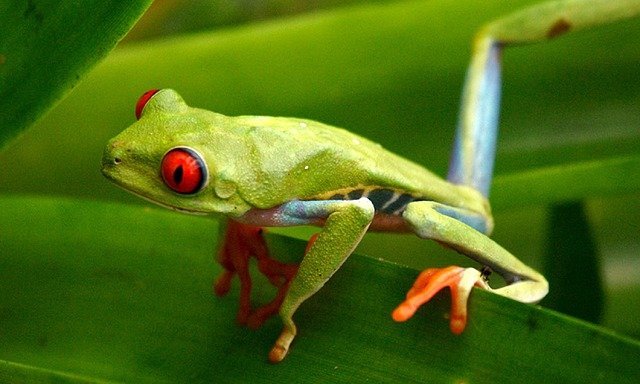When you have such a small buddy as your precious pet, it can be difficult to spot features that may signal health issues for your red-eyed tree frog. But if you’re wondering “Is my red-eyed tree frog is overweight?’, you’ve come to the right place.
Frogs are much like humans, in that they are prone to overeating and can become obese if you let them. That’s why it’s extremely important to ensure you’re feeding them their proper diet at proper times.
Is My Red-Eyed Tree Frog Overweight?
The key to finding out if your red-eyed tree frog is overweight is in the folds of their skin. Do they cover more than half of their ears? Does your tree frog have significantly more folds in his skin than a regular red-eyed tree frog? These are the questions you need to ask in order to assess your frog’s weight properly.
Keep reading to find out how to tell if your red-eyed tree frog is overweight, what to do if he/she is, and information on the proper diet and feeding schedule you should be administering to your little friend.
Check the Fold of Skin Over Their Ears
The single most surefire way to know if your red-eyed tree frog is overweight is to take a good look at the fold of skin your pet has over their ears. In a healthy red-eyed tree frog, this fold of skin will not cover their ears more than halfway. If your red-tree frog is obese, however, you will notice this fold will cover more than half of his ear, or even cover his ear entirely.
You can also examine a photo of a healthy red-eyed tree frog online. If you notice that your frog has significantly more folds in his skin than the healthy example, you may want to consider putting your friend on a diet.
Now that you know how to spot obesity in your red-eyed tree frog, let’s examine the best methods you can use to get your buddy back to a healthy weight.
How Can I Help My Overweight Red-Eyed Tree Frog?
If you notice that your red-eyed tree frog is obese, you’ll want to immediately start implementing some changes immediately.
The number one way to catalyze some weight loss in your red-eyed tree frog is to increase the size of their enclosure to avoid sedentary behavior. Get a bigger enclosure and add extra rocks and logs for your frog to jump around on; this allows for your frog to get more exercise and increase his metabolism so that he can burn off extra calories on his own.
The next step you’ll want to take is to make sure that you’re following the proper diet feeding schedule for your friend. If you find yourself feeding your pet more than is recommended in the following guideline, cut back.
[su_box title=”Our Red-eyed Tree Frog Guide”]We hope that we have answered your question. However, if you have other queries that you want to be answered we want you to have a look at our comprehensive guide to keeping red-eyed tree frogs. It is an absolute must for all tree frog owners. Just Click Here to have a look.[/su_box]
What and How Often Should I Feed My Red-Eyed Tree Frog?
Now that we know how to spot and treat obesity in red-eyed tree frogs, let’s dive into their proper diet so you can find a feeding routine that supports your friends’ health.
Red-eyed tree frogs are carnivores and eat crickets, grasshoppers, flies, and even small frogs in the wild. Per each feeding, provide three to five living crickets or similar insects that have been dusted with a supplemental powder containing calcium and necessary vitamins and minerals. How often you should feed your red-eyed tree frog depends on how old they are.
- For juvenile red-eyed tree frogs, feed two to three times a day to support healthy growth.
- For subadult red-eyed tree frogs, feed every two to three days.
- For adult red-eyed tree frogs, feed two to three times a week.
Your red-eyed tree frog also needs a source of freshwater. Proper hydration for your friend supports a healthy metabolism. Mist his enclosure several times a day with water as well to imitate the tropical climates they are used to.
You can also supplement your red-eyed tree frog’s diet with mealworms or waxworms to provide some more diverse nutrients. Don’t feed your friend too many of these though, as they are high in fat and not good for the frog in excess.
If your frog is overweight and you feed them mealworms or waxworms on a regular basis, consider reducing the number of mealworms and waxworms you administer to your frog. This could be the main culprit behind your frog’s weight problem.
Now that you know how to spot obesity in your red-eyed tree frog, make sure you are taking the proper steps to take care of your friend’s weight if you notice they are getting a little chunky. Provide food only at the right times, and in the right amounts. Make sure your tree frog is eating a diet full of diverse nutrients and is getting the proper hydration to solve any weight gain problems.




